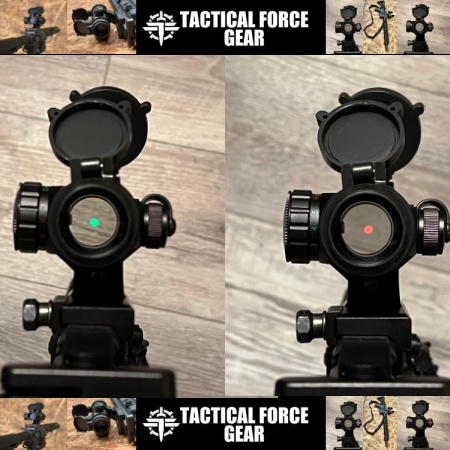Hornady has been on a roll the last few years with its line of ARC cartridges. The 6mm ARC, 22 ARC and now 338 ARC are all impressive new cartridges that don’t disappoint. But the burning question most of us have: Do they work as advertised?
The 338 ARC intrigues me and I for one want to know a lot more about it. What can it do? What can it not do? Why does it matter? For that to happen, I built what I’m calling “The Tester”. This “pistol” isn’t optimized for anything special, but rather is a jack-of-all-trades I’ll use to play around with 338 ARC to find its limits.
THE BUILD
Pros:
- Lightweight
- Quiet
- Close- and Mid-range capable
- Short enough for HD
Cons:
- Higher than normal cost
- Dedicated parts
- Magazines are iffy
338 ARC VS. 300 BLK VS. 8.6 BLK
Before we get in deep, it might help to clear up exactly what 338 ARC is. Some people think it is a 8.6 Blackout replacement, others claim it will be a 300 Blackout killer. The answer is both, kind of.
If you want a nitty gritty deep-dive, take a look at Horandy’s New 338 ARC Vs. 300 BLACKOUT Vs. 8.6 BLACKOUT.
The 338 ARC takes many of the strengths from 300 BLK and 8.6 BLK and rolls them into a single cartridge that is arguably better than either Blackout.
Energy
If you’re looking at subsonic loads, everything has a max muzzle velocity of about 1,050 feet per second (FSP), 338 ARC has a lot more energy than 300 BLK due to the larger, heavier bullets. Most 300 BLK subs are normally loaded with 200-grain bullets, while 338 ARC are around 300 grains. This translates to 338 ARC having about 200 foot-pounds (ft.lbf) more energy at the muzzle and around 110 ft.lbf at 300 yards while having effectively the same bullet drop. That ~35-percent more energy is significant.
Typical 8.6 BLK subs generally boast 300- or 342-grain bullets, putting them on par or slightly more powerful than 338 ARC subs, but with some major downsides. First, 8.6 BLK requires an AR-10 size rifle making it larger and heavier right out of the gate. Second, ammo selection is more limited due to the 8.6 BLK’s extremely high twist rate.
- 300 BLK 190gr Hornady: 1,050 FPS, 539 ft.lbf
- 338 ARC 307gr Hornady: 1,050 FPS, 752 ft.lbf
- 8.6 BLK 342gr Gorilla Ammo: 1,050 FPS, 837 ft.lbf
When it comes to supersonic, the trend remains the same with 8.6 BLK being more powerful than 338 ARC and the 338 being more powerful than 300 BLK. But with super the gap widens even more. You can massage the numbers in either direction depending on ammo choice, but looking at 300 BLK 110-grain Hornady Vs. 338 ARC 175-grain Hornady Vs. 8.6 BLK 185-grain Phantom Defense, 300 BLK falls to about half the energy of 8.6 BLK.
- 300 BLK 110gr Hornady: 2,070 FPS, 1,047 ft.lbf
- 338 ARC 175gr Hornady: 2,075 FPS, 1,673 ft.lbf
- 8.6 BLK 185gr Phantom Defense: 2,235 FPS, 2,054 ft.lbf
Cost
These really aren’t plinking calibers, but if you want to shoot more — 300 BLK is the winner. Right now, as I write this, you can find 300 BLK subs for 42 cents per round. That’s not a bad deal at all.
The 338 ARC is less expensive than you might think, but it isn’t cheap. Lowest price at the time of writing was $1.44 per round.
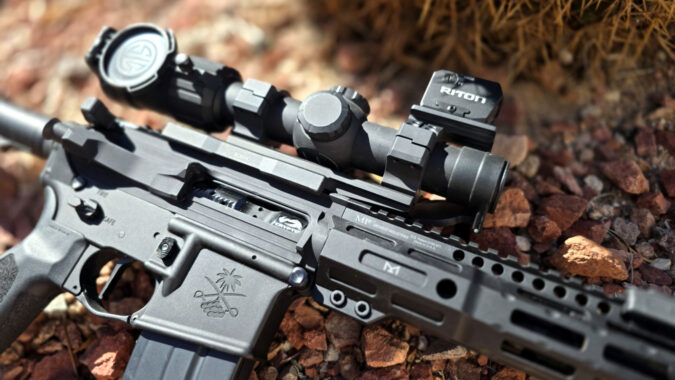
The 8.6 BLK can be painful depending on where you get it. Most of the brands supporting it are the smaller names so there isn’t a lot of economy of scale helping shooters out. Lowest price at the time of writing was $1.90 per round.
Safety
Something worth talking about is the fact that 300 BLK has, in my opinion, a design flaw. Because of how the shape and size of 300 BLK and 5.56 NATO pan out, 300 BLK can chamber and fire in 5.56 NATO rifles. Doing so almost always results in a KABOOM! that may or may not harm the shooter. Either way, it will destroy the rifle.
Search the web and you’ll find dozens of stories about it happening. Having personally seen it happen at a training class, it’s not something I recommend doing.
The 338 ARC and 8.6 BLK don’t suffer from this problem. Instead of being a safety hazard you need to be constantly on the lookout to prevent, they simply exist alongside your other rifles.
ON THE RANGE
New guns and new cartridges are always fun, but when you’re sending 307-grain pills that are Hollywood quiet, it’s really, really fun.
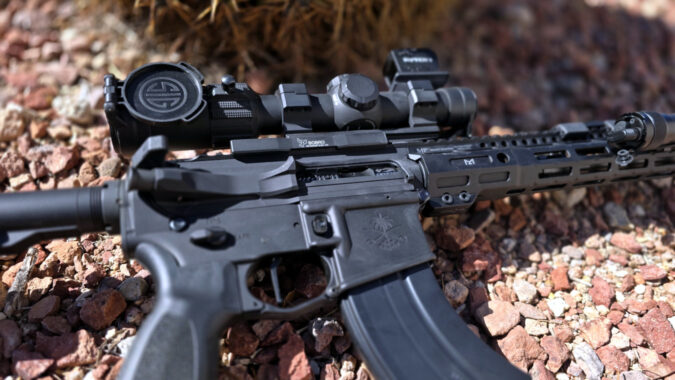
Function for the Tester was perfect once the gas was dialed in with the Faxon Firearms adjustable gas block. It’s easy to use, easy to tune and works just right. Faxon’s Gunner profile has always been a winner in my book and this barrel is no different. The perfect blend of weight and rigidity for suppressed use, it feels great in this configuration.
One downside of 338 ARC is the need for a larger bore suppressor than what most people might already have at home. While some 9mm suppressors are rated for the pressure, not all of them are, and most of the ones that could handle the cartridge haven’t been officially tested yet.
Upside, a new suppressor is always another layer of fun. TiON makes a wide range of great suppressors and I’ve gotten to test many of them at various CANCON events. But I acquired my first personal can from them for this build.
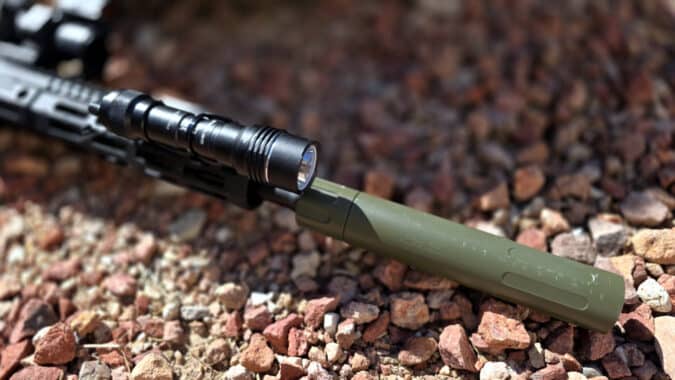
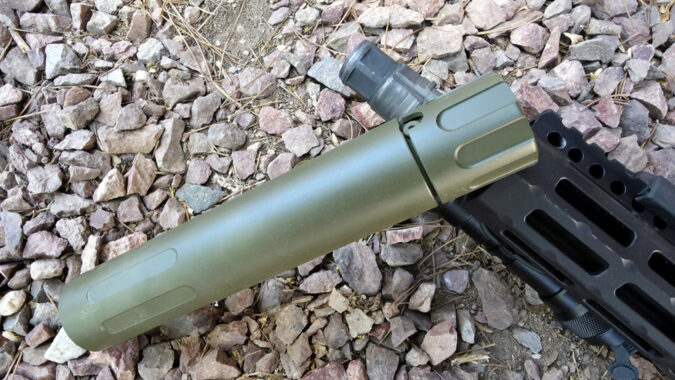
The TiON 8.6 QD is stunningly lightweight due to the all titanium construction. At 7.5-inches long, it offers a lot of volume but only weighs 11 ounces, helping the Tester to not feel front heavy. Proprietary QD system is one of the best on the market with a hand-tight ultra-secure lockup.
Green Cerakote was done by TiON and looks amazing. It’s taken some hits from being used but still looks great and is doing a solid job protecting the metal under it.
Tone is a big deal with suppressors and often more important than the actual dB rating for what makes one suppressor sound better than another. Higher tones are generally worse to most people. Something I love about TiON is that their cans always have deeper tones. Instead of a cymbal being struck, firing 338 ARC with the Dragoon sounds more like dirt being slapped.
Recoil with 338 ARC is more than 5.56 NATO and slightly more than 300 BLK, but that’s expected. Even subsonic, these are some beefy bullets getting yeeted. Feed and function have been 100 percent using Duramag 6 ARC magazines and Duramag 450 Legend magazines. Hornady recommends the 6 ARC magazine, but some brands have testing showing the 450 Legend mags working better. In my testing, it didn’t make a difference. Both worked every shot.
While this is designed for subs and personally there isn’t much interest in running supers with it, the Tester handled supers exactly as well as it did subs. More recoil, more noise but perfect function.
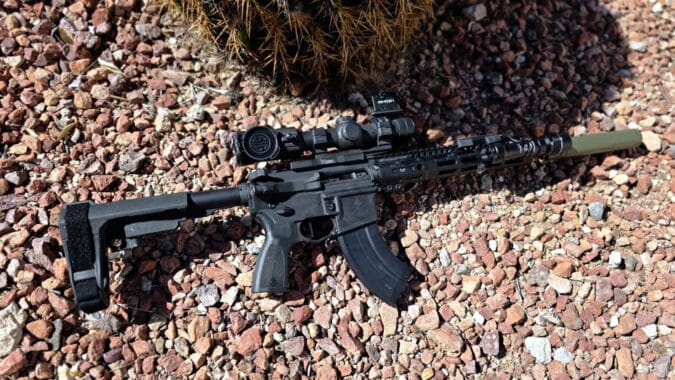
With the Horandy 307-grain SubX ammo, this gun with the TiON Dragoon is about as quiet as you can get an AR-15.
LOOSE ROUNDS
My first foray into the world of 338 ARC has been a success. The firearm works, the ammo runs, nothing went KABOOM!, and it’s ready for some real-world use. What comes next? I’m thinking dry wall testing and maybe a meat target.
Read the full article here

![338 ARC: Testing Hornady’s New Subsonic Thumper [BUILD]](https://gunreviewtactical.com/wp-content/uploads/2025/04/338-arc-3-1200x675.jpg)
